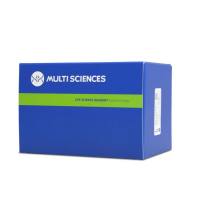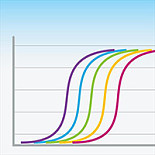巢式PCR(Nested PCR)定义、原理和步骤
互联网
73978
巢式PCR的定义
巢式PCR是一种变异的聚合酶链反应(PCR),使用两对(而非一对)PCR引物扩增完整的片段。第一对PCR引物扩增片段和普通 PCR相似。第二对引物称为巢式引物(因为他们在第一次PCR扩增片段的内部)结合在第一次PCR产物内部,使得第二次PCR扩增片断短于第一次扩增。巢 式PCR的好处在于,如果第一次扩增产生了错误片断,则第二次能在错误片段上进行引物配对并扩增的概率极低。因此,巢式PCR的扩增非常特异。
巢式PCR反应
巢式PCR通过两轮PCR反应,使用两套引物扩增特异性的DNA片断。第二对引物的功能是特异性的扩增位于首轮PCR产物内的一段DNA片断。
巢式PCR的实验步骤
第一步:目标的DNA模板蓝色的第一对引物结合。第一对引物也可能结合到其他具有相似结合位点的片段上并扩增多种产物。但只有一种产物是目的片断(图中未显示可能的多种产物)。
第二步:使用红色标记的第二套引物对第一轮PCR扩增的产物进行第二轮PCR扩增。
由于第二套引物位于第一轮PCR产物内部,而非目的片断包含两套引物结合位点的可能性极小,因此第二套引物不可能扩增非目的片断。这种巢式PCR扩增确保第二轮PCR产物几乎或者完全没有引物配对特异性不强造成的非特异性扩增的污染。
英文原文如下
Definition of Nested PCR
Nested PCR is a variation of the polymerase chain reaction (PCR), in that two pairs (instead of one pair) of PCR primers are used to amplify a fragment. The first pair of PCR primers amplify a fragment similar to a standard PCR. However, a second pair of primers called nested primers (as they lie / are nested within the first fragment) bind inside the first PCR product fragment to allow amplification of a second PCR product which is shorter than the first one. The advantage of nested PCR is that if the wrong PCR fragment was amplified, the probability is quite low that the region would be amplified a second time by the second set of primers. Thus, Nested PCR is a very specific PCR amplification.
The Nested PCR Reaction
Nested PCR requires two sets of primers which are used to amplify a specific DNA fragment using two separate runs of PCR. The second pair of primers function to amplify a smaller specific DNA fragment located within the first PCR product.
Nested PCR Reaction Diagram
Steps of the Nested PCR
Step One: The DNA target template is bound by the first set of primers shown in blue. The primers may bind to alternative, similar primer binding sites which give multiple products however only one of these PCR products give the intended sequence (multiple products not shown).
Step Two: PCR products from the first PCR reaction are subjected to a second PCR run however with a second new set of primers shown in red.
As these primers are NESTED within the first PCR product, they make it very unlikely that non-specifically amplified PCR product would contain binding sites for both sets of primers. This nested PCR amplification ensures that the PCR product from the second PCR amplification has little or no contamination from non-specifically amplified PCR products from alternative primer target sequences.








